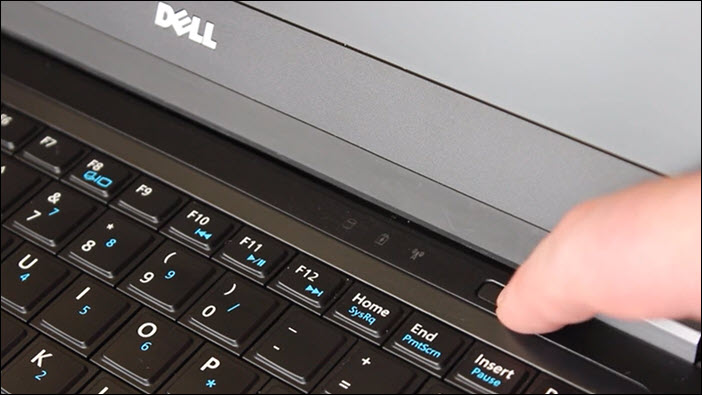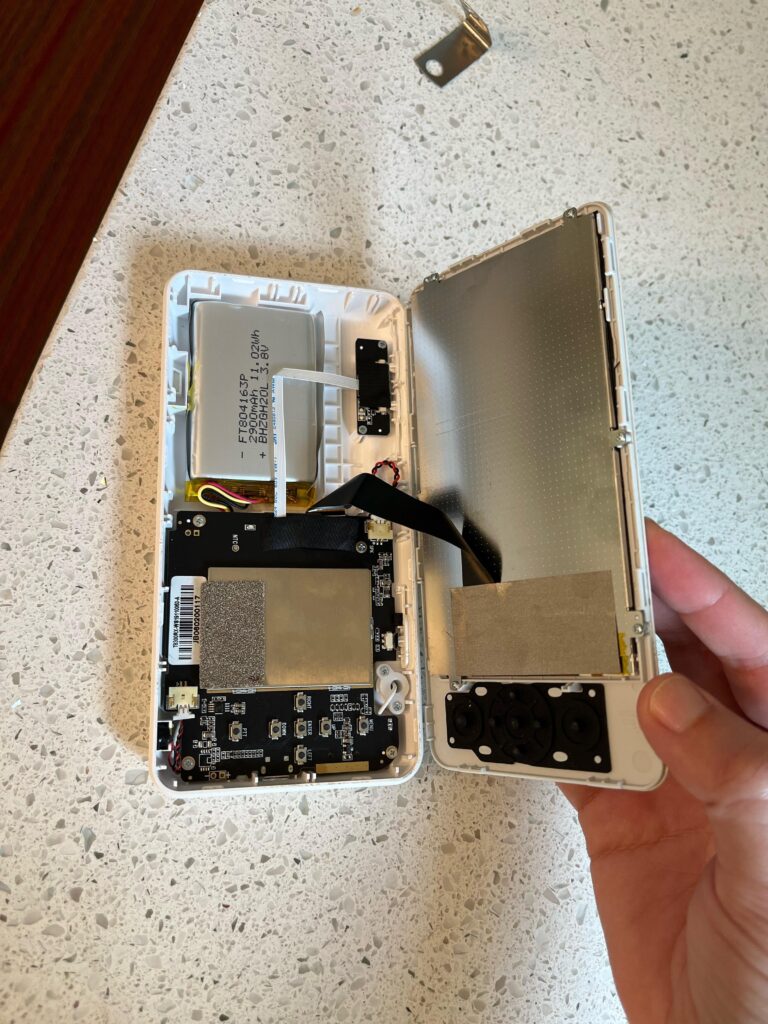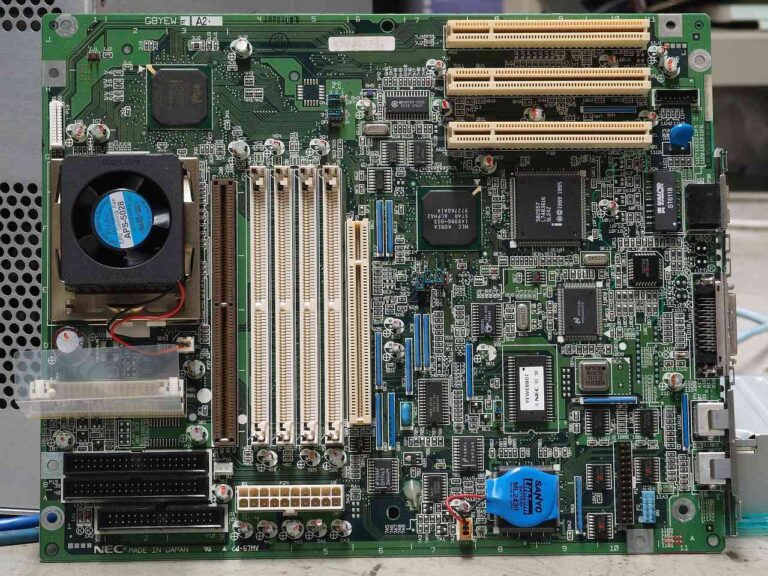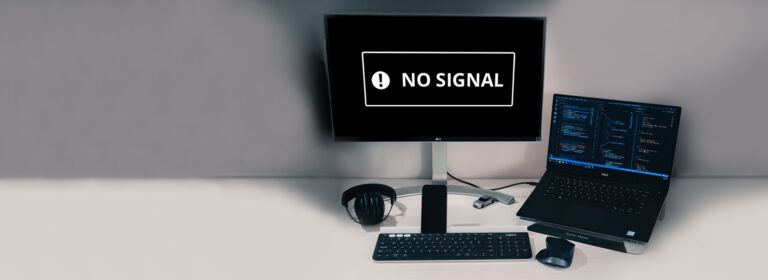Monitor Not Displaying from Laptop: Troubleshooting Tips
If your monitor is not displaying from your laptop, start by turning off the computer and monitor, then unplug the video cable connecting them. Check for any damage on the video port and cable, and if there is none, reconnect the monitor to the computer.
Additionally, try using a different cable or changing the cable connecting the external monitor to determine if the previous cable was faulty. Troubleshoot the issue by following steps such as checking for updated display drivers and ensuring the input source settings are correct.
It’s also worth investigating loose or improper connections, as well as trying a different cable for the monitor.
Confirming Power And Connectivity
When your monitor fails to display anything from your laptop, it can be frustrating and disruptive to your work or entertainment. The issue could be a result of power or connectivity problems. In this section, we will discuss the steps to confirm power and connectivity for your laptop and monitor.
Verify The Laptop And Monitor Are Powered On
The first thing to check when your monitor doesn’t display anything is if both your laptop and monitor are powered on. Ensure that the power cables for both devices are securely plugged into power outlets, and press the power buttons to turn them on. Double-check that the power indicators on both devices are activated.
Double-check All Cable Connections
The next step is to inspect all cable connections between your laptop and monitor to make sure they are secure. Start by unplugging the video cable that connects the monitor to the computer. Take a close look at the video port on both your laptop and monitor, as well as the video cable itself, to check for any signs of damage or bent pins.
If you notice any damage, it’s important to replace the cable with a new one that is not faulty. However, if there is no apparent damage, reconnect the monitor to the computer by firmly plugging in the video cable to both devices.
Review Potential Damage To Cables And Ports
If the issue persists after reconnecting the monitor, it’s crucial to assess any potential damage to the cables and ports. Look for any visible signs of damage, such as frayed wires or loose connection points.
If you find any damage, replace the damaged cables or seek professional assistance to repair the ports. It’s important to ensure that the cables and ports are in good condition for a proper connection between your laptop and monitor.
By following these steps to confirm power and connectivity for your laptop and monitor, you can effectively troubleshoot and resolve the issue of no display. Remember to always double-check the power status, secure cable connections, and assess any potential damage. These simple actions can often rectify the problem and get your monitor working again.
Monitor Display Settings And Adjustments
When using an external monitor with your laptop, it can be frustrating if the monitor doesn’t display anything. However, most of the time, this issue can be resolved by making some adjustments to the display settings. In this section, we’ll cover the necessary steps to navigate to the display settings on your laptop, ensure that the correct display mode is selected, adjust the resolution settings to match the monitor, and check for display override options in BIOS/UEFI.
Navigate To Display Settings On The Laptop
To begin troubleshooting the issue, you’ll need to navigate to the display settings on your laptop. Follow these steps:
- Open the Settings on your laptop.
- Click on System.
- Choose Display.
Ensure The Correct Display Mode Is Selected (duplicate/extend)
Once you’ve accessed the display settings, make sure that the correct display mode is selected. This step is crucial as it determines how the laptop and the external monitor work together. Follow these steps:
- Scroll down to the Multiple displays section.
- Click on the dropdown menu and select either Duplicate or Extend, depending on your preference.
Adjust Resolution Settings To Match The Monitor
Another important aspect of troubleshooting display issues is adjusting the resolution settings to match the monitor. Follow these steps:
- Scroll down to the Resolution section.
- Click on the dropdown menu and select the resolution that matches your external monitor’s native resolution.
Check For Display Override Options In Bios/uefi
If the previous steps didn’t resolve the issue, it’s worth checking for display override options in the BIOS/UEFI settings. This step involves accessing the computer’s firmware interface and making sure that the display settings are configured correctly. Here’s how:
- Restart your laptop.
- During the startup process, press the appropriate key to access the BIOS/UEFI settings (common keys include Del or F2).
- Navigate to the Display or Graphics section.
- Look for any display override options and ensure they are disabled or set to the appropriate configuration.
- Save the changes and exit the BIOS/UEFI settings.
By following these steps, you should be able to resolve the issue of your monitor not displaying from your laptop. Remember to double-check all connections and cables as well, as they can sometimes be the root cause of the problem. With the correct display settings and adjustments in place, you can enjoy a seamless experience using an external monitor with your laptop.
Update Or Reinstall Display Drivers
To troubleshoot a laptop not displaying on the monitor, start by checking the video cable for damage or bent pins. If there are no issues, try reconnecting the monitor to the computer. You can also try changing the cable connecting the external monitor, as a faulty cable might be the problem.
Make sure to check the display settings on your laptop as well.
Update or Reinstall Display Drivers One common reason why a monitor may not be displaying correctly from a laptop is outdated or faulty display drivers. Display drivers are software that allow your computer’s operating system to communicate with the graphics hardware and facilitate the proper display of images on your monitor.Identify Current Display Driver Versions
Before updating or reinstalling display drivers, it’s important to identify the current versions installed on your laptop. Follow the steps below to find this information: 1. Press the Windows key and the ‘R’ key simultaneously to open the Run dialog box. 2. Type ‘dxdiag’ into the textbox and click ‘OK’ to open the DirectX Diagnostic Tool. 3. In the DirectX Diagnostic Tool window, navigate to the ‘Display’ tab. 4. Here, you will find information about your current display driver, including the name, manufacturer, and version number. Make a note of this information for reference.Download And Install The Latest Drivers
Now that you know the current display driver version, it’s time to update to the latest version. Follow the steps below to download and install the latest drivers: 1. Visit the website of your laptop manufacturer. Look for a support or drivers section. 2. Search for the specific model of your laptop and locate the display drivers for your operating system. 3. Download the latest version of the display drivers onto your laptop. 4. Once the download is complete, locate the downloaded file and double-click on it to initiate the installation process. 5. Follow the on-screen instructions to install the display drivers. 6. Restart your laptop to ensure that the changes take effect.Consider Rolling Back Drivers If Issues Persist Post-update
In some cases, updating display drivers may cause issues or compatibility errors. If you encounter problems with your monitor displaying correctly after updating the drivers, you may need to roll back to the previous version. Follow the steps below to roll back the display drivers: 1. Press the Windows key and the ‘R’ key simultaneously to open the Run dialog box. 2. Type ‘devmgmt.msc’ into the textbox and click ‘OK’ to open the Device Manager. 3. In the Device Manager, expand the ‘Display adapters’ category. 4. Right-click on the display driver and select ‘Properties’. 5. Go to the ‘Driver’ tab and click on the ‘Roll Back Driver’ button. 6. Follow the prompts to complete the rollback process. 7. Restart your laptop to apply the changes.Reinstall Drivers From The Laptop Manufacturer’s Website
If updating or rolling back the display drivers did not resolve the issue, you can try reinstalling the drivers from the laptop manufacturer’s website. Follow the steps below: 1. Visit the website of your laptop manufacturer and navigate to the support or drivers section. 2. Search for the specific model of your laptop and locate the display drivers for your operating system. 3. Download the display drivers onto your laptop. 4. Uninstall the current display drivers by following the steps mentioned earlier, but this time choose the ‘Uninstall device’ option instead of ‘Roll Back Driver’. 5. Restart your laptop to complete the uninstallation process. 6. Once your laptop has restarted, locate the downloaded display drivers and double-click on the file to initiate the installation process. 7. Follow the on-screen instructions to reinstall the display drivers. 8. Restart your laptop once again to ensure that the changes take effect. By updating or reinstalling display drivers, you can often resolve issues where the monitor is not displaying correctly from your laptop. Remember to check for the latest drivers from your laptop manufacturer’s website and consider rolling back drivers if issues persist after an update.
Credit: www.dell.com
Monitor Not Displaying From Laptop: Specific Fixes
When you’re facing the issue of your monitor not displaying from your laptop, it can be frustrating and worrisome. However, there are specific fixes you can try to troubleshoot and resolve the problem efficiently. In this article, we’ll explore three potential solutions to the issue, each with their own steps and processes. By following these recommendations, you can hopefully enjoy a functional and hassle-free monitor display once again.
Test The Monitor With A Different Laptop Or Pc
If your laptop monitor is not displaying, one possible solution is to test the monitor with a different laptop or PC. By doing so, you can determine whether the issue lies with your laptop or the monitor itself. To perform this test, follow these steps:
- Turn off both the laptop and the monitor.
- Unplug the video cable connecting the monitor to the computer.
- Inspect the video port on both your laptop and the monitor, ensuring there is no visible damage or bent pins.
- If no damage is found, reconnect the monitor to the computer.
- Turn on both the laptop and the monitor and see if the display appears.
If the monitor displays properly with a different laptop or PC, it indicates that the issue is likely with your laptop, not the monitor. Move on to the next possible solution to resolve the problem.
Perform A Laptop Hardware Diagnostics Test
If your laptop monitor is still not displaying properly, it may be beneficial to perform a hardware diagnostics test. This can help identify any potential hardware issues that are causing the problem. Follow these steps to execute a laptop hardware diagnostics test:
- Turn off your laptop.
- Restart your laptop and continually press [Enter] to boot into the BIOS/UEFI mode.
- Within the BIOS/UEFI menu, navigate to the hardware diagnostics section (the exact location may vary depending on your laptop brand and model).
- Select the option to run a comprehensive hardware diagnostics test.
- Wait for the test to complete, and take note of any errors or issues detected.
If the hardware diagnostics test reveals any hardware problems, such as issues with the graphics card or display components, consult with a professional technician or the laptop manufacturer for further assistance. If no hardware issues are detected, proceed to the next potential solution.
Reset Monitor To Factory Settings If Available
If your laptop monitor continues to display incorrectly, resetting the monitor to its factory settings can be an effective solution. Follow these steps to reset your monitor:
- Locate the menu buttons on your monitor.
- Press the menu button to access the monitor’s settings.
- Navigate to the “Reset” or “Factory Reset” option using the arrow buttons.
- Press the appropriate button (e.g., “OK” or “Enter”) to initiate the reset process.
- Wait for the monitor to reset to its factory settings.
- Restart your laptop and check if the monitor display has been restored.
If your monitor does not have a factory reset option or if this step does not resolve the issue, continue to the next solution.
By trying these specific fixes for a monitor not displaying from your laptop, you can increase your chances of successfully resolving the problem. Remember to test the monitor with a different laptop or PC, perform a laptop hardware diagnostics test if necessary, and reset the monitor to factory settings if available. Hopefully, one of these solutions will help you regain a functional and clear monitor display.
Utilizing Different Ports And Adapters
If you’re experiencing issues with your laptop monitor not displaying, one of the most common solutions is to utilize different ports and adapters. This approach allows you to test alternative connection methods and ensure that the problem is not related to a faulty cable or port. By identifying all available port types on your laptop and trying different connection options such as HDMI, VGA, DisplayPort, and USB-C, you can troubleshoot and resolve the display problem more effectively.
Identify All Available Port Types On The Laptop
Before proceeding to troubleshoot, it’s important to identify all the available port types on your laptop. These ports may vary depending on the make and model of your device. Some common port types include:
- USB-C
- HDMI
- VGA
- DisplayPort
Refer to your laptop’s user manual or manufacturer’s website to determine the specific ports available on your device. Once you have identified the port types, you can proceed to test different connection methods.
Try Alternative Connection Methods (hdmi, Vga, Displayport, Usb-c)
Once you have identified the available port types on your laptop, you can try alternative connection methods to fix the monitor display issue. This involves connecting your laptop to an external monitor or display using different ports such as HDMI, VGA, DisplayPort, or USB-C.
- Turn off your laptop and the external monitor.
- Unplug the video cable connecting the monitor to the laptop.
- Inspect the video ports on both the laptop and the monitor for any damage or bent pins.
- If there is no visible damage, reconnect the monitor to the laptop using a different port type.
Testing different connection methods allows you to determine if the issue is specific to a particular port or cable.
Test With Different Cable Types And Adapters If Needed
If the issue persists after trying alternative connection methods, it may be necessary to test with different cable types and adapters. This step ensures that the problem is not caused by a faulty cable or incompatible adapter.
- Try using a different video cable, such as an HDMI cable or a VGA cable.
- If your laptop doesn’t have the required port type, use an adapter to connect to the monitor. For example, if your laptop has a USB-C port but the monitor only has HDMI or VGA ports, you can use a USB-C to HDMI or VGA adapter.
By testing with different cable types and adapters, you can ensure compatibility and rule out any issues related to faulty cables or adapters.
Remember to turn off your laptop and monitor before making any connections or changes. If the issue still persists after trying these troubleshooting steps, it is recommended to seek professional assistance or consult the laptop manufacturer for further support.
Reach Out For Expert Support
Having trouble with your laptop monitor not displaying? Try troubleshooting by turning off the computer and monitor, checking for any damage to the video port or cable, and reconnecting the monitor. You can also try changing the cable connecting the external monitor or updating your display drivers.
Contact The Laptop Manufacturer For Technical Support
If you’ve tried troubleshooting your laptop monitor not displaying and are still unable to resolve the issue, it’s time to reach out to the experts. Contacting the laptop manufacturer for technical support is a wise move, as they have the knowledge and expertise to assist you. They can provide step-by-step guidance, diagnose the problem, and offer solutions tailored to your specific laptop model.Consider Seeking Help From A Professional Computer Technician
If you prefer hands-on assistance or if the issue seems more complicated than you can handle, it may be beneficial to seek help from a professional computer technician. They possess in-depth knowledge of computer hardware and software and can diagnose and fix the problem with your laptop monitor. A professional technician can also provide maintenance tips and recommendations to avoid similar issues in the future.Look Into Warranty Or Insurance Options For Repairs Or Replacements
In some cases, when your laptop monitor fails to display, the issue may require repairs or even a replacement. If your laptop is still under warranty, it’s crucial to explore this option as repairs or replacements may be covered. Contact the laptop manufacturer to inquire about the warranty terms and conditions. Additionally, if you have insurance coverage for your laptop, check with your insurance provider to see if it covers repairs or replacements for a malfunctioning monitor. In conclusion, when facing the frustrating issue of a laptop monitor not displaying, don’t hesitate to reach out for expert support. Contacting the laptop manufacturer for technical support, seeking assistance from a professional computer technician, and exploring warranty or insurance options can help resolve the issue effectively. Remember, expert assistance will not only provide you with a solution but also ensure that your laptop is functioning optimally.Frequently Asked Questions For Monitor Not Displaying From Laptop
Why Is My Laptop Not Detecting My External Monitor?
If your laptop is not detecting your external monitor, try these steps: 1. Turn off the computer and monitor, then unplug and check the video cable and ports for damage. 2. Reconnect the monitor to the computer. 3. Change the cable connecting the external monitor.
If the new one works, the previous cable was faulty. 4. Troubleshoot your monitor and laptop by following the instructions provided by Dell, PCMag, or Microsoft Community. 5. Ensure your display drivers are up to date. 6. Check for loose or faulty cables.
If the problem persists, seek professional assistance.
Why Is My Laptop Saying No Signal To My Monitor?
If your laptop is showing no signal to your monitor, try these troubleshooting steps. Turn off and unplug both the computer and monitor. Check the video port on both devices and the cable for damages or bent pins. If everything looks fine, reconnect the monitor.
You can also try using a different cable or connecting the monitor to another device to see if it works.
Why Can’t I Use My Laptop Screen As A Monitor?
You may not be able to use your laptop screen as a monitor because it may not have an HDMI port. If it doesn’t, you may need to purchase an adapter. Once you’ve connected the cables, switch your laptop’s input source and start using it as a monitor.
Why Is There Suddenly No Display On My Monitor?
Check the video cable for any damage or bent pins. If there is no damage, try reconnecting the monitor to the computer. Changing the cable connecting the external monitor might also solve the issue. If all else fails, check the display settings on your computer or update the display drivers.
Conclusion
To troubleshoot and fix the issue of your monitor not displaying from your laptop, there are several steps you can take. Start by turning off both your computer and the monitor, and then unplug the video cable connecting them. Check for any damage or bent pins on the video port and cable.
If everything looks fine, reconnect the monitor to your computer. Additionally, you can try changing the cable or using a different external monitor to determine if the issue lies with the previous cable or monitor. Remember to update your display drivers as well, as outdated drivers can cause display problems.
By following these steps, you should be able to resolve the issue of your monitor not displaying from your laptop.




